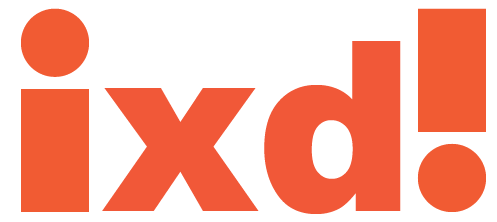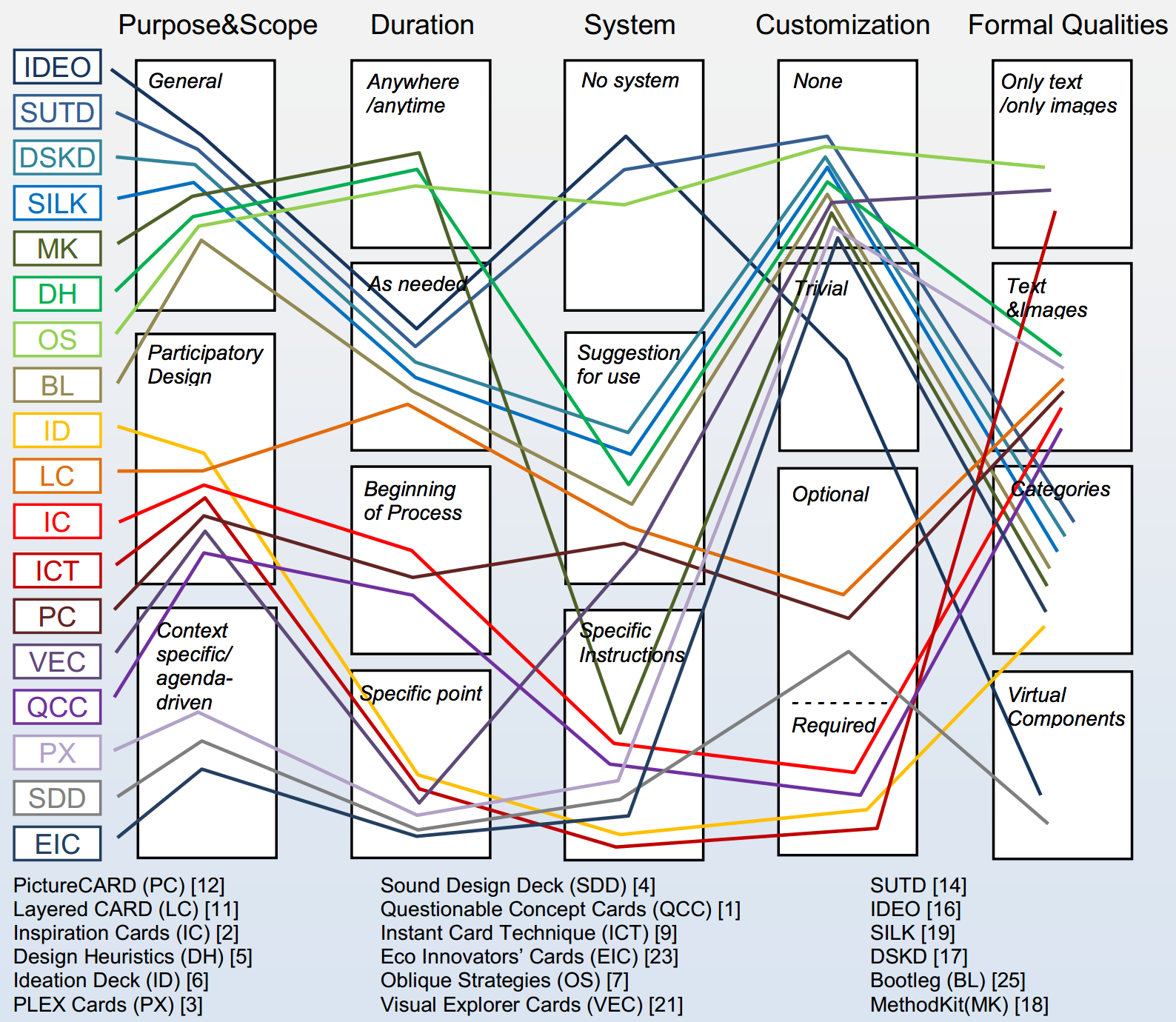
‘Design methods are like toothbrushes. Everyone uses them, but no one likes to use someone else’s.’*
*Harrison,S.,Tatar,D.:OnMethods.Interactions18(2),10–11(2011)
There are many examples of unique method card systems to inspire designers, many have similar features and formal qualities, yet it is not easy to get an overview of the available card systems in order to decide which to use, and when. As suggested in the above quote attributed to John Zimmerman, designers often develop their own methods or appropriate widely known methods to best suit their needs, yet there is a tendency to use methods that are familiar instead of venturing out. When should we as designers use someone’s toothbrush and when should we make our own?
Although there are many examples of design method cards intended to assist or provide structure to the design process, there has not been a thorough articulation of the strengths and weaknesses of the various examples. We review eighteen card-based design tools in order to understand how they might benefit designers. The card-based tools are explained in terms of five design dimensions including the intended purpose and scope of use, duration of use, methodology, customization, and formal/material qualities. Our analysis suggests three design patterns or archetypes for existing card-based design method tools and highlights unexplored areas in the design space. The paper concludes with recommendations for the future development of card-based methods for the field of interaction design. We presented our findings at the INTERACT 2013 conference in Cape Town, South Africa.
The pre-press version of the paper is available to download and read here:
Method Card Design Dimensions: a survey of card-based design tools.
However, please go to the publisher’s site below to download the official paper with the meta-data and for full referencing information:
Official version of the paper in the Proceedings of INTERACT2013.
Wölfel, C., Merritt, T., Method Card Design Dimensions: A Survey of Card-Based Design Tools. In P. Kotz, et al. (Eds.): INTERACT 2013, Part I, LNCS 8117, pp. 479–486. IFIP International Federation for Information Processing (2013).
Some related links include the following:
Method card examples
IDEO Method Cards (and App) http://www.ideo.com/work/ideo-method-card-app/
SUTD – http://design.sutd.edu.sg/ (resources link)
Design School of Kolding – http://www.designskolenkolding.dk/index.php?id=2241
http://www.dcdr.dk/dk/materiale/dokumenter/dskd-method-cards-pdf
The Deck – initiative to implement a pattern language of game design via cards – http://www.soundingames.com/index.php?title=Deck
SILK method deck from Kent: http://socialinnovation.typepad.com/silk/silk-method-deck.html
AU.dk – Technology and Domain cards – http://www.peterdalsgaard.com/publications
Mehtod Cards for projects and personal development – http://www.methodkit.com/
77 Design Heuristic cards: https://www.designheuristics.com/ with howto: https://www.designheuristics.com/wp-content/uploads/2012/08/Design-Heuristic-Workshop.pdf
Design Play Cards for Sustainability
http://www.designplaycards.com/#!where-to-get-them/c497
Research papers in which cards are used:
John Vines, Mark Blythe, Stephen Lindsay, Paul Dunphy, Andrew Monk, and Patrick Olivier. 2012. Questionable concepts: critique as resource for designing with eighty somethings. In Proceedings of the SIGCHI Conference on Human Factors in Computing Systems (CHI ’12). ACM, New York, NY, USA, 1169-1178. DOI=10.1145/2207676.2208567 http://doi.acm.org/10.1145/2207676.2208567
Kim Halskov and Peter Dalsgaard. 2006. Inspiration card workshops. In Proceedings of the 6th conference on Designing Interactive systems (DIS ’06). ACM, New York, NY, USA, 2-11. DOI=10.1145/1142405.1142409 http://doi.acm.org/10.1145/1142405.1142409
Andrés Lucero and Juha Arrasvuori. 2010. PLEX Cards: a source of inspiration when designing for playfulness. In Proceedings of the 3rd International Conference on Fun and Games (Fun and Games ’10). ACM, New York, NY, USA, 28-37. DOI=10.1145/1823818.1823821 http://doi.acm.org/10.1145/1823818.1823821
Valter Alves and Licinio Roque. 2011. A deck for sound design in games: enhancements based on a design exercise. In Proceedings of the 8th International Conference on Advances in Computer Entertainment Technology (ACE ’11), Teresa Romão, Nuno Correia, Masahiko Inami, Hirokasu Kato, Rui Prada, Tsutomu Terada, Eduardo Dias, and Teresa Chambel (Eds.). ACM, New York, NY, USA, , Article 34 , 8 pages. DOI=10.1145/2071423.2071465 http://doi.acm.org/10.1145/2071423.2071465
Related to the above paper: http://www.soundingames.com/index.php?title=Deck
Daly, Shanna R., et al. “Assessing Design Heuristics for Idea Generation in an Introductory Engineering Course.” International Journal of Engineering Education 28.2 (2012): 463.
http://www.engin.umich.edu/teaching/crltengin/web-files/AssessingDesignHeuristicsIJEE2012.pdf
Michael Golembewski and Mark Selby. 2010. Ideation decks: a card-based design ideation tool. In Proceedings of the 8th ACM Conference on Designing Interactive Systems (DIS ’10). ACM, New York, NY, USA, 89-92. DOI=10.1145/1858171.1858189 http://doi.acm.org/10.1145/1858171.1858189
Taylor, G. The Oblique Strategies Web Site. http://www.rtqe.net/ObliqueStrategies/
Burns, Alex. “Oblique Strategies for Ambient Journalism.” M/C Journal 13.2 (May. 2010). 21 Mar. 2013 <http://www.journal.media-culture.org.au/index.php/mcjournal/article/view/230>.
Elke Beck, Marianna Obrist, Regina Bernhaupt, and Manfred Tscheligi. 2008. Instant card technique: how and why to apply in user-centered design. In Proceedings of the Tenth Anniversary Conference on Participatory Design 2008 (PDC ’08). Indiana University, Indianapolis, IN, USA, 162-165.
Daniel Lafrenière, Tom Dayton, and Michael Muller. 1999. Variations of a theme: card-based techniques for participatory analysis and design. In CHI ’99 Extended Abstracts on Human Factors in Computing Systems (CHI EA ’99). ACM, New York, NY, USA, 151-152. DOI=10.1145/632716.632807 http://doi.acm.org/10.1145/632716.632807
Michael J. Muller. 2001. Layered participatory analysis: new developments in the CARD technique. In Proceedings of the SIGCHI Conference on Human Factors in Computing Systems (CHI ’01). ACM, New York, NY, USA, 90-97. DOI=10.1145/365024.365054 http://doi.acm.org/10.1145/365024.365054
http://www.it.hiof.no/interaction-design/papers/muller2001lpa.pdf
PictureCARD: A Storytelling Tool for Task Analysis
Michael W. Tschudy, Elizabeth A. Dykstra-Erickson, Matthew S. Holloway
http://ojs.ruc.dk/index.php/pdc/article/view/146

